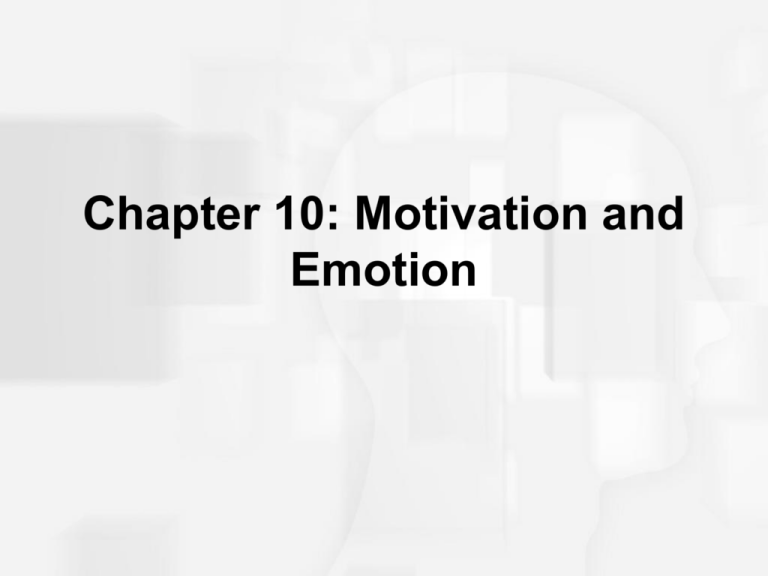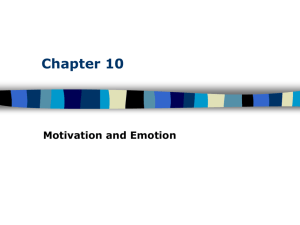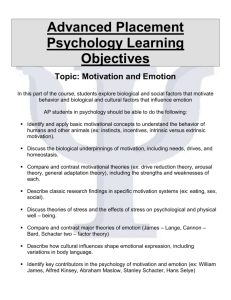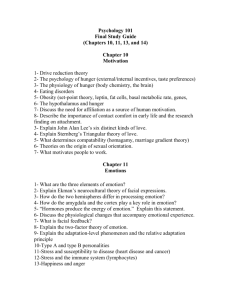
Chapter 10: Motivation and
Emotion
Motivational Theories and Concepts
• Motives – needs, wants, desires leading to
goal-directed behavior
• Drive theories – seeking homeostasis (a
state of physiological equilibrium or stability)
• -Hunger would be an example of a drive.
Motivational Theories and Concepts
• Incentive theories – regulation by external
stimuli
This seems very close to operant
conditioning.
• Evolutionary theories – maximizing
reproductive success
Figure 10.2 The diversity of human motives
The Motivation of Hunger and Eating:
Biological Factors
• Brain regulation
– Lateral and ventromedial Hypothalamus:
Monitors our physiological processes that
are related to hunger
• Glucose and digestive regulation
– Glucostatic theory: hunger is dependent on
our glucose levels
Figure 10.3 The hypothalamus
The Motivation of Hunger and Eating:
Environmental Factors
• Learned preferences and habits
– Exposure
– When, as well as what
• Stress
– Link between heightened arousal/negative
emotion and overeating
Eating and Weight: The Roots of Obesity
• Evolutionary explanations
• Genetic predisposition for weight?
adoption study – The weight of adults who
had been adopted was more like their
biological parents than their adopted
parents
• The concept of set point/settling point
Figure 10.5 The heritability of weight
Sexual Motivation and Behavior:
Determining Desire
• Hormonal regulation
– Estrogens
– Androgens
– Testosterone: related to more interest in
sex, sex at an earlier age & extramarital
affairs.
• Erotic materials: most studies find porn is
not related to sex crimes. However,
aggressive porn may lead to aggressive
behavior toward women.
Figure 10.6 Rape victim-offender relationships
Figure 10.7 Parental investment theory and mating preferences
Figure 10.8 The gender gap in how much people think about sex
Gender differences
• What do women look for in a partner?
• What do men look for in a partner?
Figure 10.10 Gender and potential mates’ financial prospects
Figure 10.11 Gender and potential mates’ physical attractiveness
The Mystery of Sexual Orientation
• Heterosexual – Bisexual – Homosexual
– A continuum
• Theories explaining homosexuality
– Environmental: Do we learn to be gay?
– Biological: Is there a genetic component?
– Interactionist
Figure 10.12 Homosexuality and heterosexuality as endpoints on a continuum
Figure 10.13 How common is homosexuality?
Figure 10.14 Genetics and sexual orientation
Figure 10.16 The gender gap in orgasm consistency
The Elements of Emotional Experience
• Cognitive component
– Subjective conscious experience
– Positive psychology
• Physiological component
– Bodily (autonomic) arousal
• Behavioral component
– Characteristic overt expressions
Figure 10.20 The amygdala and fear
Figure 10.22 Cross-cultural comparisons of people’s ability to recognize emotions from facial expressions
Theories of Emotion
• James-Lange
– Feel afraid because pulse is racing
• Cannon-Bard
– Thalamus sends signals simultaneously to
the cortex and the autonomic nervous
system
• Schacter’s Two-Factor Theory
– Look to external cues to decide what to
feel
• Evolutionary Theories
– Innate reactions with little cognitive
interpretation
Figure 10.23 Theories of emotion
Figure 10.24 Primary emotions
Happiness
• Common sense notions incorrect
– Income, age, parenthood, intelligence, and
attractiveness largely uncorrelated
– Physical health, good social relationships,
religious faith, and culture modestly
correlated
– Love, marriage, work satisfaction, and
personality strongly correlated
• Subjective rather than objective reality
important
Figure 10.29 Possible causal relations among the correlates of happiness







